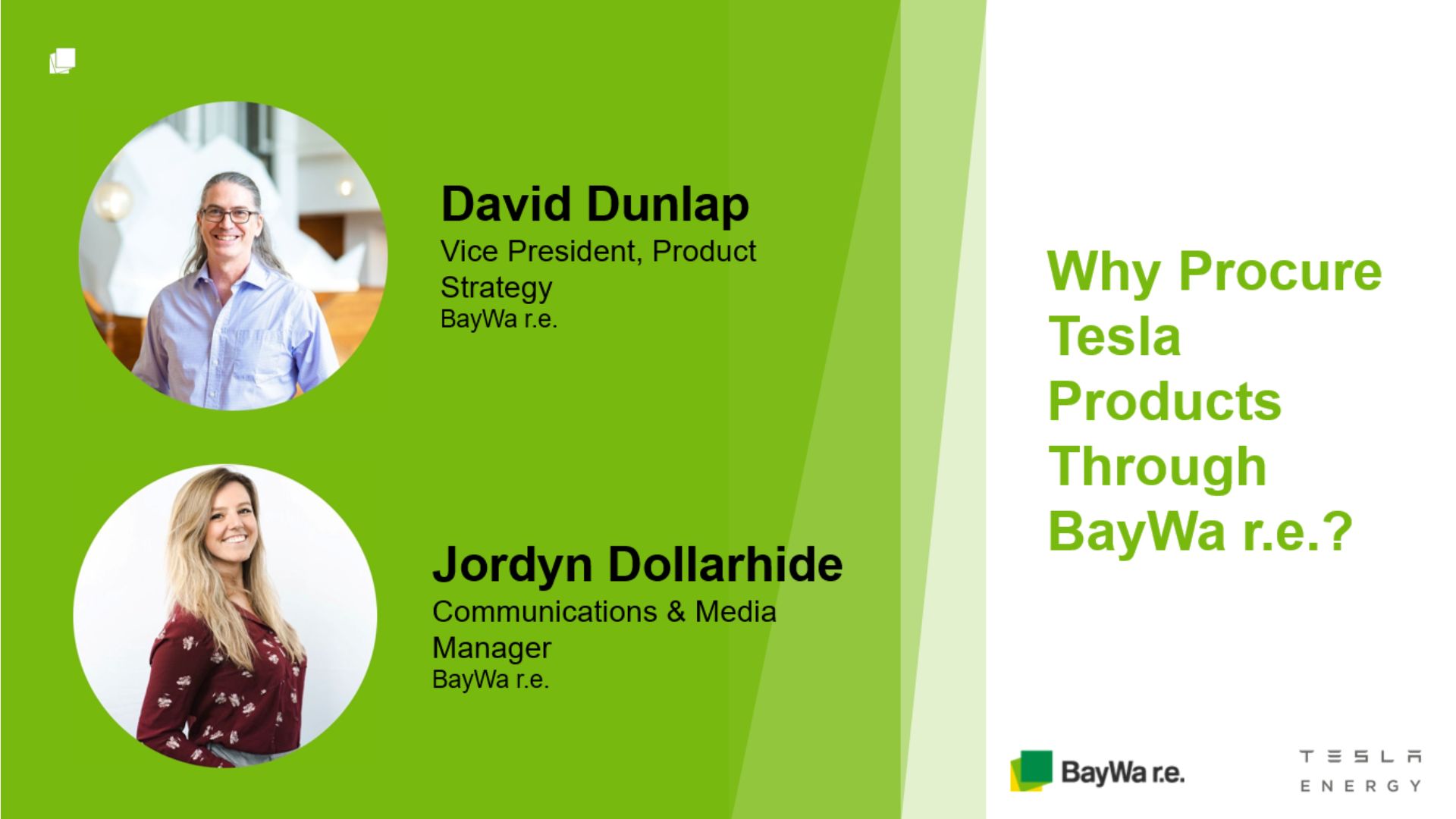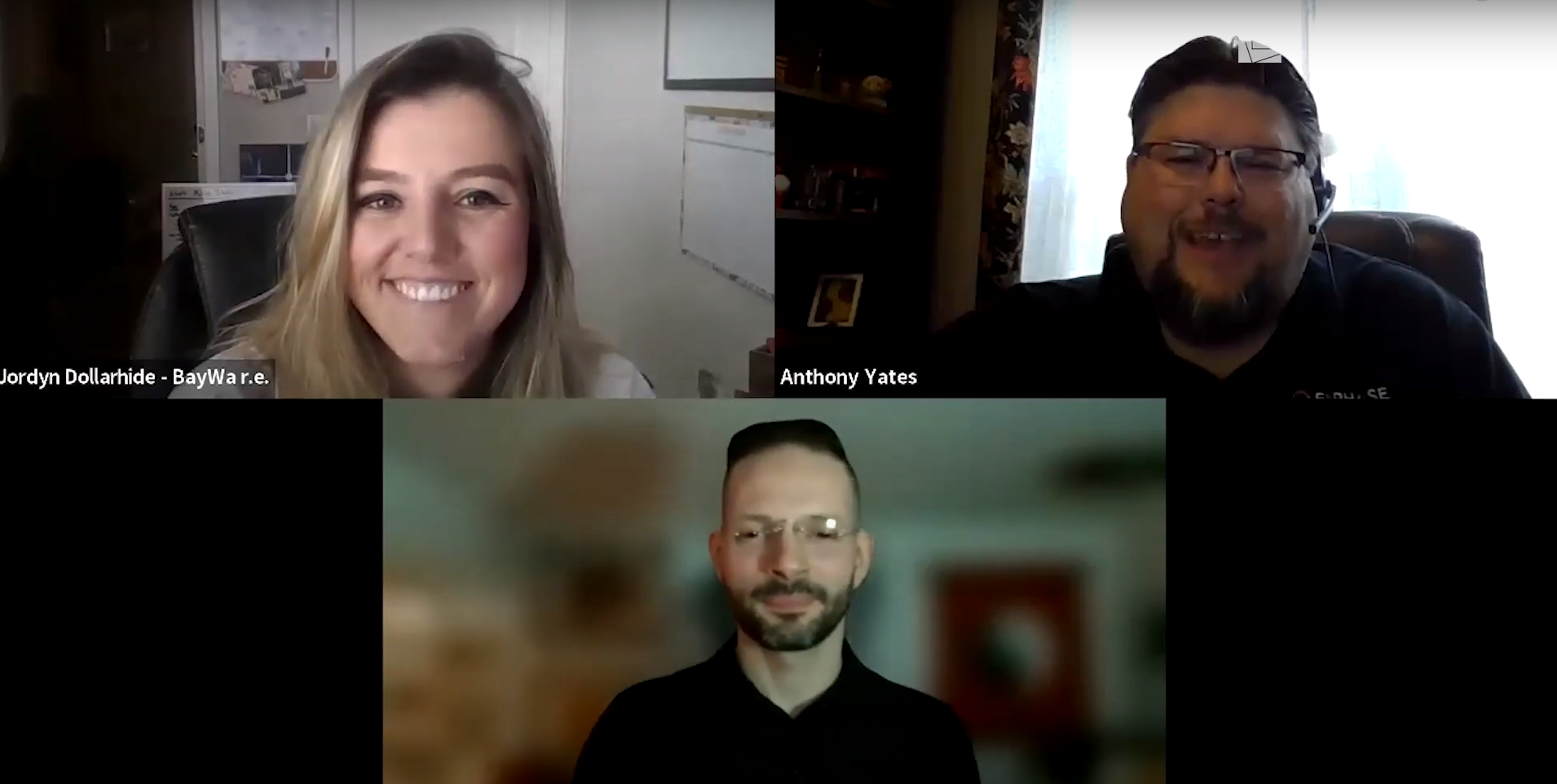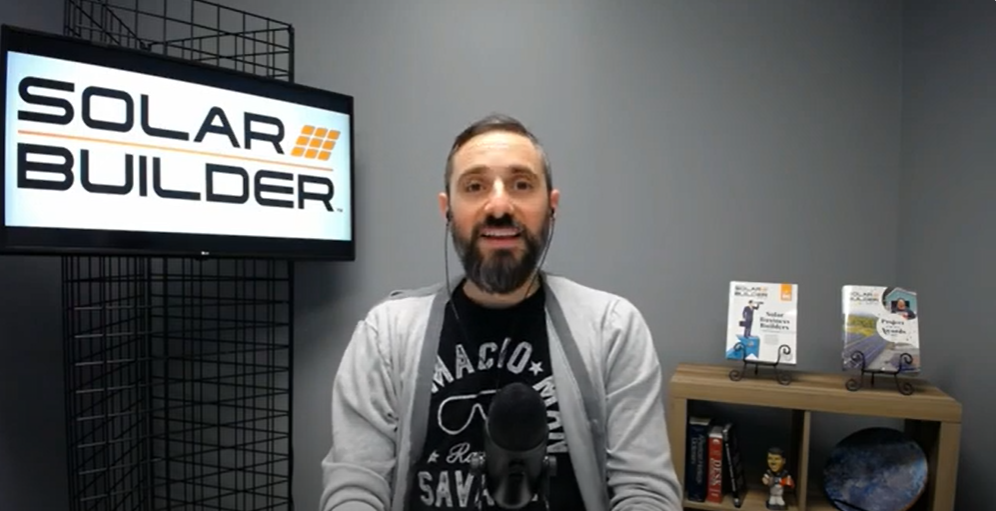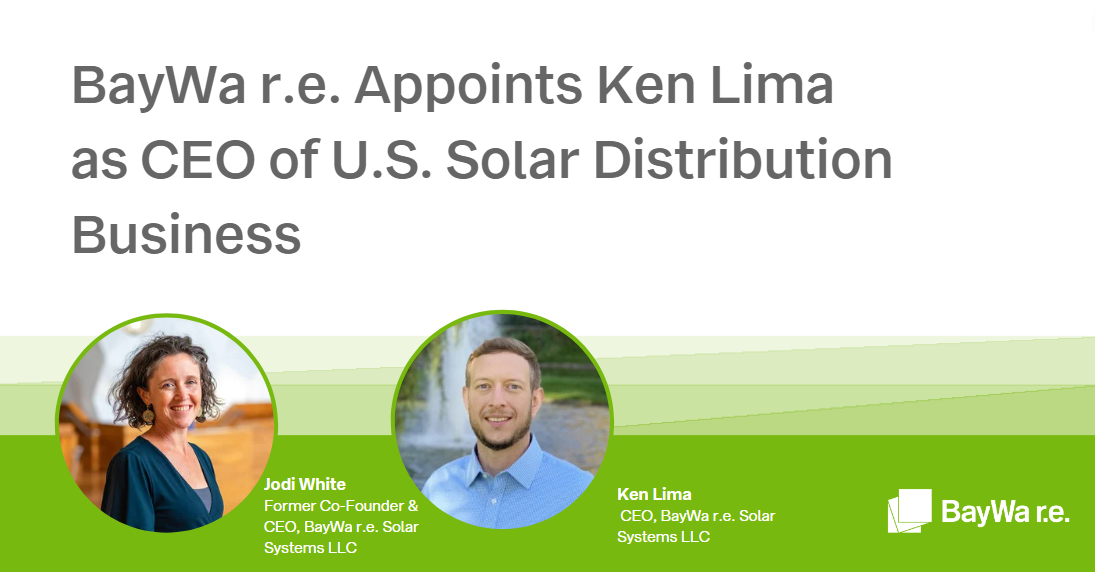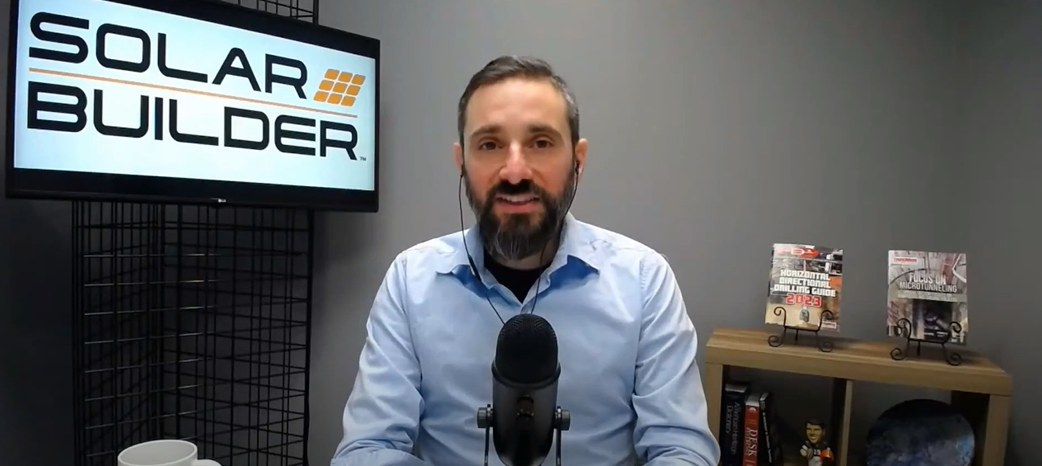Tom Miller (Editor, Solar r.e.view): Can you give me a quick overview of where we are with batteries? Where they started in the market and where we are now?

David Dunlap, Director of Operations, BayWa r.e. Solar Systems – Photo, Tom Miller
David Dunlap (Director of Operations, BayWa r.e. Solar Systems): Sure. Of course, batteries are nothing new, but really they were the foundation of making initial solar systems functional twenty four hours a day. Early adopters of solar were off-grid, remote locations. They were able to generate electricity during the day but also needed electricity at night, so batteries were used to store it. The systems were relatively low-power and costly, and not terribly-well integrated. So one really had to almost be an electrician in order to operate their solar systems. There was a bit of a barrier to entry there.
Tom: You really had to be dedicated!
David: Yes! And then, of course, as more and more remote locations became absorbed into the suburbs, the need for being off the grid was decreased. And the adoption throughout the years – of having solar connected to the grid – eliminated a lot of the complexity. So there was a huge ramp up of solar adoption that did not include batteries. People thought of solar as just the panel. Of course you had inverters as well, but batteries weren’t part of the discussion.
Tom: So where are we now?
David: We’re kind of coming full circle now, where in certain markets the grid can no longer accept the input of the solar without disruption to the way the grid is managed. Or the cost of energy is so high – or high during certain times of the day – that people are now looking for ways to utilize their self-generated solar power during alternate times. So the battery comes back into the discussion.
Tom: What are some of the challenges or misconceptions when we think about what batteries can do?
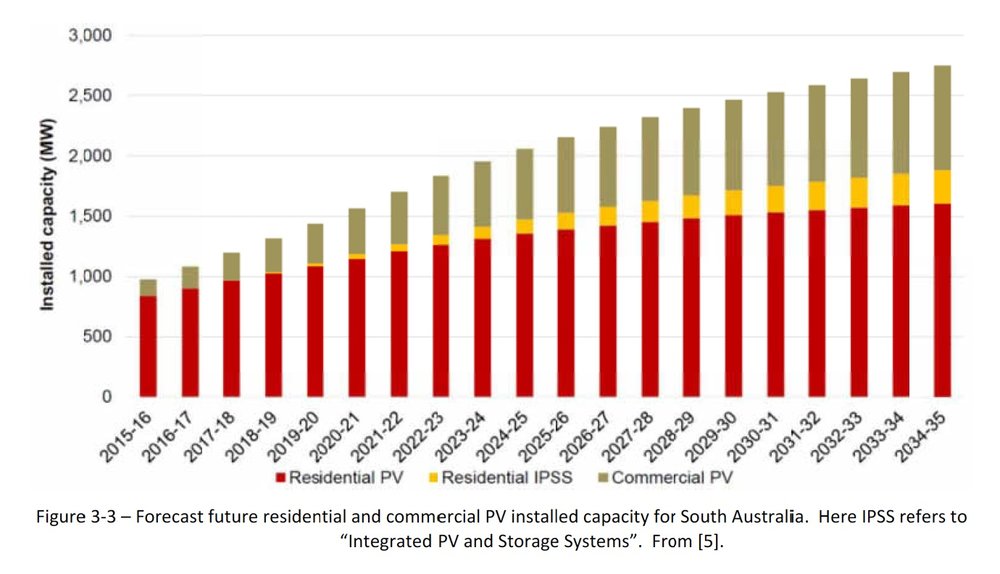 We can look to Australia and Europe for signs of where storage is heading. Graph, ESCRI-SA
We can look to Australia and Europe for signs of where storage is heading. Graph, ESCRI-SA
David: The challenge in the marketplace today is around a misconception about what the batteries are intended to do, or what the goal of the homeowner might be. And so, if you live in a home that is grid connected and you’re used to always having power when you turn on the light switch, you may not know why you want batteries. You just know that you’ve heard people talk about storage. You made the decisions to do solar and now you hear people saying, “you should do storage,” and you say, “great – but why?”
I think it’s important at the installer level that we’re having the conversation with the homeowners about, “why do you want storage? What do you think you know about storage?” Not to be challenging, but to really understand and cut through some of the confusion that exists.
Is the motivation to disconnect from the grid? A lot of people are talking about that today. They don’t want a utility bill and they want to disconnect. We forget that just because our electric bill has a certain cost associated with it, that’s actually not the true cost of generating, storing, and distributing our own power.
Tom: So what questions should installers be asking their customers?
David: I think the starting point should be, “What do you know about batteries? And what do you think batteries are going to do for you?” I think that it’s important that before the installer offers a solution they understand what the need is. Is the need a real need? Or is the need a desire? And that’s fine if it is! We buy a lot of things based on desire. But if the solution is not going to answer or address the need or desire, then it’s going to feel like adding storage was not money well spent. There’s going to be disappointment.
Tom: You may have the same type of conversation about going solar?
“Energy storage is the #1 new offering planned for next year. While 60% of solar installers reported offering this capability today, another 16% are planning to offer it in 2017. No other new product or service was nearly as popular.”
David: Yes. The questions are similar. With solar, the questions might be: Are you trying to offset 100% of your consumption? Or are you just trying to make a dent in your utility bill? Are you making an investment in the long-term power needs of your home? Or are looking to disconnect from the grid? Or are you trying to make a point? Are you trying to say: “I want clean, non carbon-based electricity for my home”? There are all kinds of different reasons that someone would choose to adopt solar. And, in turn, there are also many reasons why someone would want to do storage.
Tom: So what are the reasons that I might want storage?
David: I think a lot of the conversation right now is around utilizing storage to shift when power is consumed from when it can be produced. So if we’re only producing power during the day—when we’re not at home—but we need to consume it at night, we need a way to store that power from the daytime into the nighttime. We want to shift our usage time.
There needs to be, perhaps, a financial reason to do that. An example might be high electricity rates in the afternoon, like in southern states, when everyone is running their air conditioners. A lot of utilities now have made the most expensive time [to purchase power] during the day. So if you can avoid buying power during the daytime, and shift it to the nighttime, you’ve made a much more meaningful impact to your bill than just when you were producing energy during the middle of the day. Arbitrage is what we would call that. Shifting the time of use of that energy in order to mitigate a high electric bill. That could be one reason why one would consider batteries.
Tom: Okay. How about another example?
David: Another reason is if grid power is unreliable. Do they get shut off from power periodically? Then we’re talking back-up power. That’s a very different use consideration than just shifting the energy usage from during the middle of the day. With backup power, you need to have that available and ready to go at any moment—the moment the power goes off. That could be a Tuesday at noon or a Sunday at night. So the amount of storage that you have—and keeping those batteries at a full state of charge—becomes very different from charging and discharging—maybe two cycles—during the day. [Charging and discharging] is not going to guarantee that you’ll have a back-up power source at the time you need. So those are very different use cases, and probably represent the ends of the spectrum of where batteries come into play. So if we don’t understand that, we’re going to have a hard time choosing a particular battery solution.
Tom: So what will BayWa r.e. Solar Systems be offering this year, in term of batteries?
Enphase AC Battery – Photo, Enphase
David: This year we’re going to be offering, initially, two different battery solutions. One from Enphase, the AC battery, which is designed for the first use-case I was talking about—where we’re constantly charging and discharging throughout the day.
LG Chem is another company that we’ll be carrying. And their batteries are designed around having power when you need it. You can do the rate arbitrage or you can have it as backup power when you want. Enphase is not designed for when the grid goes down. There’s a fundamental difference in the architecture of the batteries, so it’s important that the installer is familiar with the systems and understands what the homeowner is asking for.
Tom: For a variety of reasons some homeowners are waiting to go solar. Or waiting to get into storage. It might be price, or the pace at which the technology is changing… Do you think that when it come to batteries—are these products ready?
David: The products are ready. There’s no doubt. And there’s no doubt that there will be an evolution of the technology. Just like we’ve seen in the panel space the last nine months and before. Prices will change: they’ll likely come down as production goes up and capacity goes up.
Photo, LG Chem
So there’s always going to be the argument that, “I should wait for the next generation to get a fast, better, cheaper, whatever.” But I don’t think it’s too soon to talk about what your specific energy goals are. And really come to an understanding—at a homeowner and installer level—what is interesting, exciting, and useful about storage? Where do you want to be in that space? What are your customer’s energy goals? And start to get informed about it. Because it is complicated. And we’re not used to talking about it.
Tom: Or used to talking about how we use energy?
David: Yeah, I think most of us are pretty blind to our energy usage and where energy comes from. And right now, perhaps, the biggest pain point is simply our utility bill. And if we believe that going solar is going to eliminate our utility bill—that might not be true. And we need to be honest about that. We can mitigate that bill. But we need to be honest about: “I’m still connected to the grid. I’m still paying the meter fee. I’m still paying a basic usage, or connection fee. There will be some months when I’m not generating enough power to offset my consumption. So there will be a bill. And if I want to disconnect from the grid, what would the true cost be?” I think most people don’t understand how much power they use and therefore how much storage would be required to run their home. It’s not one Tesla Power Wall, it’s twelve or fifteen. Everyone’s usage is different.
“I think the starting point should be: what do you know about batteries? And what do you think batteries are going to do for you?”
Tom: And now we’re back to education.
David: Yeah. We’re back to the basics of educating the homeowner. They don’t need to be an electrician. But basic knowledge about: “Here’s what I consume. Here’s what the system I’m installing will produce. Are they in balance? How does my behavior influence the consumption—up or down—and what is the capacity of the system to mitigate that?”
.jpg)
So to go back to your original question about timing: the time is now! We need to be looking at [storage] and talking about it. While the right time to buy always depends, certainly any day is a great day for solar. Any day is a great day for storage. But understanding the personal goals for going that route, I think, will lead to a more satisfying experience and a better solution in the end.
Tom: So just wrapping up now: can you talk briefly about the “connected home” and the conversations installers can be having around that?
David: When we’re thinking about the place batteries have in a home energy system: we’ve got solar on the roof, we’ve got some aspect of energy storage, we have an energy management system, and in many newer homes, smart appliances. We’re moving more towards a connected home, or a smart home. And so, having a “battery plant” aspect to that home is a natural adjunct to those pieces.
It’s a great discussion to have, and I think the installer wants to have some awareness about: what are the customer’s goals around holistic energy management of their home? And having a pre-wired port for storage to plug in to—sometime in the future—just makes sense.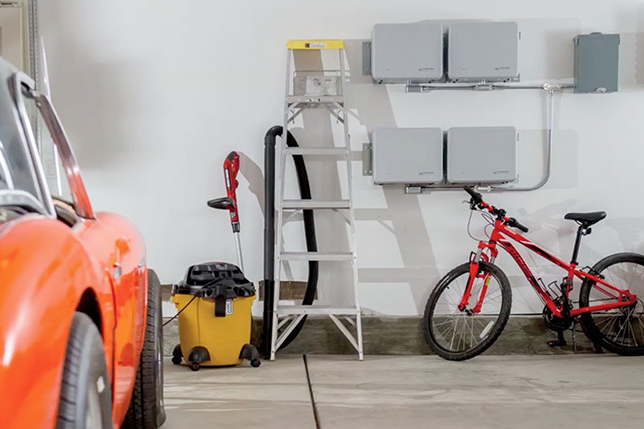
If in the initial installation, you talk about storage and they say, “I’m not ready to do storage,” that’s fine. Let’s start with the energy management and the solar and here’s where the storage would go. Here’s what you can think about. Let’s talk rough sizes. What are you trying to do? Are you trying to mitigate a high electric bill or do you want to unplug?
Tom: And when you’re ready to make a choice, call me?
David: Absolutely! I think that’s a great opportunity for installers to keep in mind. Historically, we’ve thought about solar as a single point of sale. Some installers have broken it up into a few different visits. “Maybe I’ll install your monitoring system as a first start. And then I’ll come back in a month and we’ll analyze your consumption together, and then I can design your system to fit your use case.” And now we’ve got another opportunity to ask, “Have you thought about storage?” Now you have an opportunity to go back and install the storage system.
Tom: Customer acquisition cost is low.
David: Yes! The cost of customer acquisition, in that case, is very, very low. You already have the customer. They already know they like you. They already trust you. It’s almost better than a referral. You have the opportunity to sell again to the same customer.
Tom: Okay. Thanks for taking the time, David. It was great to talk with you.
David: Absolutely. You’re welcome.
